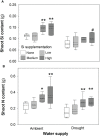Field application of silicon alleviates drought stress and improves water use efficiency in wheat
- PMID: 36438110
- PMCID: PMC9682199
- DOI: 10.3389/fpls.2022.1030620
Field application of silicon alleviates drought stress and improves water use efficiency in wheat
Abstract
Detrimental impacts of drought on crop yield have tripled in the last 50 years with climate models predicting that the frequency of such droughts will intensify in the future. Silicon (Si) accumulation, especially in Poaceae crops such as wheat (Triticum aestivum L.), may alleviate the adverse impacts of drought. We have very limited information, however, about whether Si supplementation could alleviate the impacts of drought under field conditions and no studies have specifically manipulated rainfall. Using field-based rain exclusion shelters, we determined whether Si supplementation (equivalent to 39, 78 and 117 kg ha-1) affected T. aestivum growth, elemental chemistry [Si, carbon (C) and nitrogen (N)], physiology (rates of photosynthesis, transpiration, stomatal conductance, and water use efficiency) and yield (grain production) under ambient and drought (50% of ambient) rainfall scenarios. Averaged across Si treatments, drought reduced shoot mass by 21% and grain production by 18%. Si supplementation increased shoot mass by up to 43% and 73% in ambient and drought water treatments, respectively, and restored grain production in droughted plants to levels comparable with plants supplied with ambient rainfall. Si supplementation increased leaf-level water use efficiency by 32-74%, depending on Si supplementation rates. Water supply and Si supplementation did not alter concentrations of C and N, but Si supplementation increased shoot C content by 39% and 83% under ambient and drought conditions, respectively. This equates to an increase from 6.4 to 8.9 tonnes C ha-1 and from 4.03 to 7.35 tonnes C ha-1 under ambient and drought conditions, respectively. We conclude that Si supplementation ameliorated the negative impacts of drought on T. aestivum growth and grain yield, potentially through its beneficial impacts on water use efficiency. Moreover, the beneficial impacts of Si on plant growth and C storage may render Si supplementation a useful tool for both drought mitigation and C sequestration.
Keywords: Triticum aestivum L.; carbon capture; cereals; climate change; drought stress; silica; water deficits.
Copyright © 2022 Johnson, Chen, Rowe and Tissue.
Conflict of interest statement
The research was partially funded by Agripower Australia Ltd who provided the product used for the silicon supplementation. This was regulated under contract issued by Western Sydney University as part of an Industry Partnership Grant with payment being independent of research findings. Agripower Australia provided voluntary feedback on the manuscript but did not attempt to influence the interpretations or conclusions of the work. The authors declare that the research was conducted in the absence of any commercial or financial relationships that could be construed as a potential conflict of interest.
Figures






Similar articles
-
The Effects of Foliar Supplementation of Silicon on Physiological and Biochemical Responses of Winter Wheat to Drought Stress during Different Growth Stages.Plants (Basel). 2023 Jun 20;12(12):2386. doi: 10.3390/plants12122386. Plants (Basel). 2023. PMID: 37376009 Free PMC article.
-
Combined application of zinc and silicon alleviates terminal drought stress in wheat by triggering morpho-physiological and antioxidants defense mechanisms.PLoS One. 2021 Oct 7;16(10):e0256984. doi: 10.1371/journal.pone.0256984. eCollection 2021. PLoS One. 2021. Retraction in: PLoS One. 2022 Aug 3;17(8):e0272195. doi: 10.1371/journal.pone.0272195. PMID: 34618822 Free PMC article. Retracted.
-
Silicon uptake by a pasture grass experiencing simulated grazing is greatest under elevated precipitation.BMC Ecol. 2018 Dec 4;18(1):53. doi: 10.1186/s12898-018-0208-6. BMC Ecol. 2018. PMID: 30514265 Free PMC article.
-
Fascinating regulatory mechanism of silicon for alleviating drought stress in plants.Plant Physiol Biochem. 2021 Sep;166:1044-1053. doi: 10.1016/j.plaphy.2021.07.005. Epub 2021 Jul 7. Plant Physiol Biochem. 2021. PMID: 34280603 Review.
-
Is Silicon a Panacea for Alleviating Drought and Salt Stress in Crops?Front Plant Sci. 2020 Aug 18;11:1221. doi: 10.3389/fpls.2020.01221. eCollection 2020. Front Plant Sci. 2020. PMID: 32973824 Free PMC article.
Cited by
-
Effects of leaf silicon on drought performance of tropical tree seedlings.Biol Lett. 2024 Mar;20(3):20230451. doi: 10.1098/rsbl.2023.0451. Epub 2024 Mar 6. Biol Lett. 2024. PMID: 38442870 Free PMC article.
-
The beneficial impact of silicon on wheat drought resilience is dependent on cultivar and stress intensity.Front Plant Sci. 2025 Aug 21;16:1661405. doi: 10.3389/fpls.2025.1661405. eCollection 2025. Front Plant Sci. 2025. PMID: 40918958 Free PMC article.
-
Integrated physiological, transcriptomic, and metabolomic analyses of drought stress alleviation in Ehretia macrophylla Wall. seedlings by SiO2 NPs (silica nanoparticles).Front Plant Sci. 2024 Feb 2;15:1260140. doi: 10.3389/fpls.2024.1260140. eCollection 2024. Front Plant Sci. 2024. PMID: 38371410 Free PMC article.
-
Limited effects of crop foliar Si fertilization on a marginal soil under a future climate scenario.Heliyon. 2023 Dec 18;10(1):e23882. doi: 10.1016/j.heliyon.2023.e23882. eCollection 2024 Jan 15. Heliyon. 2023. PMID: 38192753 Free PMC article.
-
Bamboo Biochar and Sodium Silicate Alleviate Oxybenzone-Induced Phytotoxicity via Distinct Mechanisms for Sustainable Plant Protection.Plants (Basel). 2025 Aug 2;14(15):2382. doi: 10.3390/plants14152382. Plants (Basel). 2025. PMID: 40805731 Free PMC article.
References
-
- Agarie S., Uchida H., Agata W., Kubota F., Kaufman P. B. (1998). Effects of silicon on transpiration and leaf conductance in rice plants (Oryza sativa L.). Plant Prod. Sci. 1, 89–95. doi: 10.1626/pps.1.89 - DOI
-
- AGT (2022) Australian Grain technologies - our varieties. Available at: https://www.agtbreeding.com.au/varieties (Accessed 25 August 2022).
-
- Brás T. A., Seixas J., Carvalhais N., Jägermeyr J. (2021). Severity of drought and heatwave crop losses tripled over the last five decades in Europe. Environ. Res. Lett. 16, 065012. doi: 10.1088/1748-9326/abf004 - DOI
LinkOut - more resources
Full Text Sources
Research Materials

